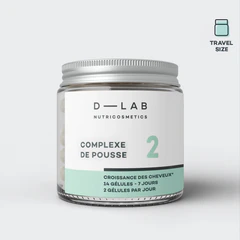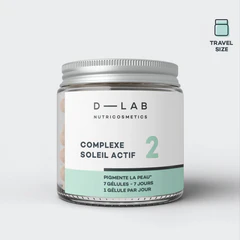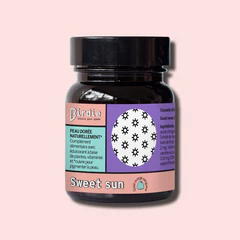
In this article, Célia Vepori Lucciardi, facialist and founder of the Institute A Perla Rara shows you how to enjoy the sun safely!
L'exposition au soleil et le bronzage ont été mis à la mode en 1920 par Coco Chanel. Mais à cette époque, on ne pouvait pas connaître les conséquences des expositions répétées à cet ami chaleureux, car on arborait alors ombrelles et chapeaux à larges bords pour conserver le teint laiteux des héroïnes de romans.
Today, only the Western world advocates a matte, tanned complexion. In much of the rest of the world, the opposite is true: a fair complexion is a sign of beauty, purity and social success.
The sun's rays fall into several categories: infrared, visible light, ultraviolet, X-rays and gamma rays.
Today, we're going to focus on ultraviolet rays, the most harmful radiation on the list. They are classified into three types: UVC, UVB and UVA. Here are a few details.
UVC is the most dangerous form of ultraviolet radiation. Used as germicides in hospitals, they attack biological molecules by affecting DNA, giving them a very high carcinogenic potential. Fortunately, the ozone layer filters out most of this radiation.
UVB rays are the main cause of "sunburn". They induce cell degeneration that leads to melanoma, the skin cancer. In fact, they generate molecular disorders which, if repeated, saturate the DNA repair system and lead to "errors" in the genome of the affected cells.
UVA rays, on the other hand, cause premature actinic ageing (i.e. sun-induced ageing ), as well as accelerating the development of pigmentation spots. Although UVB is the main cause of skin cancer, UVA can also contribute. They are responsible for the production of free radicals. These molecules initiate chain reactions that damage DNA, proteins and lipids, and generate cancer cells. Beware: these UV rays pass through glass.
I. What is tanning?
Melanocytes are found in our cells and constantly produce melanin, the biological pigments that characterize our skin, hair and eye color.
The sun stimulates this process by producing even more melanin, which is released into the skin cells, coloring the skin and giving it a tan.
UVA rays initially cause " immediate pigmentation ", which produces a rapid but ephemeral tan. A few days later, so-called "delayed pigmentation" appears, the tanning pigmentation. This is at its peak after 20 days.
Meanwhile, the skin thickens. This is a natural reaction designed to protect us from the sun. However, this thickening does not provide sufficient protection.
II. What is sunburn?
In the event of overexposure, UVA and UVB rays will damage our skin and create solar erythema, more commonly known as " sunburn ".
It reaches its maximum intensity after about 24 hours. It is not a real burn, but an inflammatory reaction of the cells.
UVB rays destroy our cells, resulting in redness. Then the cells break off and the skin peels.
Peeling is very risky because these cells have a high potential for cancerous transformation.
Every time the skin is exposed to UV rays and tans or burns, every cell in the skin is altered, as well as the DNA. Although the skin can repair superficial damage such as sunburn, the damage to the skin cells and DNA remains.
III. Actinic ageing
Sun-induced aging differs from chronological aging. The first difference is that it induces premature aging.
What's more, sun-induced aging is completely unstructured: wrinkles appear in a totally anarchic way, whereas chronological aging would intensify expression lines first, then those due to skin sagging.
Wrinkles are deeper and more numerous, and the skin rapidly loses its elasticity. Pigmentation spots also appear.
IV. Sun and vitamin D
The sun is also an ally. Among other things, it enables the synthesis of vitamin D, which is often lacking, even in favourable latitudes. Vitamin D is actually a hormone and not a vitamin.
It plays a key role in a wide range of metabolic reactions, particularly in autoimmune diseases. Therefore, the latest studies tend to show that vitamin D supplementation in higher doses than those usually recommended would have beneficial effects on diseases such as vitiligo, psoriasis, multiple sclerosis, covid and many others. Although the current recommended dose is 600-800 iu per day, this would eventually be increased.
Today, the new recommendations are close to the results obtained after 20 minutes of daily exposure, arms and legs bare and without a sun protection filter, which would correspond to 10,000 iu. Please note that any increase in dosage should not be made without the advice of a doctor.
V. Our solutions
Winter: protect your skin with a minimum sunprotection factor of 25-30, which you change throughout the day. Be careful when traveling in the city/car, and protect yourself behind windows.
On rainy or grey days, remember that the sun's rays penetrate clouds, which filter out only 50% of ultraviolet rays. So beware of foggy, seemingly sunless weather.
In spring, prepare your skin for the sun by exfoliating to regenerate it and create a healthy base. Increase the sun protection factor of your sunscreen for the new sunny days.
Moisturize your skin and force yourself to drink. Prepare your skin for the sun by using the D-LAB Active Sun Complex which tans the complexion without the sun, while preparing the skin for tanning.
Rich in antioxidants and anti-free radicals, this treatment will enhance your skin's beauty while providing it with all the elements it needs to increase its resistance and better protect it.
In summer, an SPF 50 with broad-spectrum UVA protection is highly recommended. Be sure to renew your cream every two hours at most, and always use 100% natural filters for the benefit of both you and our environment.
Even with sun cream, avoid basking in the sun, and take a wide-brimmed hat with you wherever you go.
The Duo Eclat-Total combines the Sunshine Complex and the Soothed Skin Complex to intensify the tan and provide the skin with total protection against the sun's harmful effects. In particular, the Skin Calming Complex a microencapsulated melon extract titrated in SOD. SOD plays an essential role in preventing oxidative stress, and also offers very high protection against UV damage, making it an ideal summer ally. You'll offer your skin greater resistance to ultraviolet rays and sunburn, while reducing UV-induced inflammation.
Autumn is the time when pimples break out. To protect itself from UV rays, the skin defends itself against the sun's aggression by thickening. This excess creates an obstruction in the sebaceous glands' orifice, giving rise to microcysts and other inflamed comedones.
When it is no longer exposed to the sun, the skin will refine again, returning to its original shape. This is when things start to go wrong, revealing accumulation. Gentle exfoliation is called for, and the Skin-Perfect Programme will allow a complete reset of your skin through its detox and regeneration.





